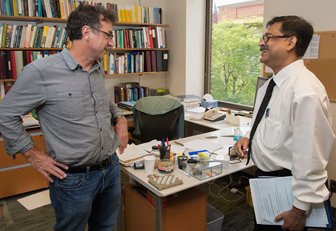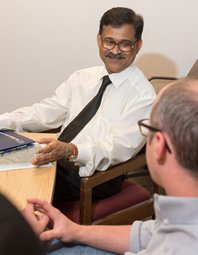Syracuse Scientists Host University of Calcutta Official
Vice Chancellor Dhrubajyoti Chattopadhyay explores 'inter-institutional collaborative agreement' with Syracuse

Scientists in Syracuse University’s College of Arts and Sciences recently met with a top official from the University of Calcutta, one of India’s oldest and largest universities.
Vice Chancellor Dhrubajyoti Chattopadhyay spent the day with professors in the College’s chemistry and physics departments and with representatives from the University and the College of Engineering and Computer Science discussing the possibility of an inter-institutional collaborative agreement.
Chattopadhyay’s visit to Syracuse was part of a larger regional tour, designed to increase his university’s global footprint.
“The University of Calcutta consistently ranks as one of India’s top institutions,” says Karin Ruhlandt, Arts and Sciences' interim dean and Distinguished Professor of Chemistry. “The opportunity to partner with such an illustrious university, particularly in science and technology, could be mutually beneficial. I look forward to exploring the idea more closely.”
Mark Bowick, the J. Dorman Steele Professor of Physics and director of the soft matter program, says: “One clear avenue to strengthening ties with Calcutta would be through the fundamental science of highly flexible, or squishy objects, ranging from atomically thin graphene sheets at room temperature, to polymer brushes, to cells and tissues. These objects fall within the domain of soft matter and are of current interest to our physics, chemistry, biology, and materials science communities.”
During his daylong visit to Syracuse, Chattopadhyay met with nearly a dozen people, including Eric Spina, vice chancellor and provost; Gina Lee-Glauser, vice president for research at Syracuse and research professor of mechanical and aerospace engineering in Engineering and Computer Science; Chilukuri K. Mohan, interim dean-designate of Engineering and Computer Science; and Paul Fitzgerald, associate dean for science, mathematics, and research of Arts and Sciences.
Cathryn Newton, Arts and Sciences' dean emerita and professor of interdisciplinary sciences, informed Syracuse of the possibility of Chattopadyay’s visit and helped organize it.
Vice Chancellor Dhrubajyoti Chattopadhyay spent the day with professors in the College’s chemistry and physics departments and with representatives from the University and the College of Engineering and Computer Science discussing the possibility of an inter-institutional collaborative agreement.
Chattopadhyay’s visit to Syracuse was part of a larger regional tour, designed to increase his university’s global footprint.
“The University of Calcutta consistently ranks as one of India’s top institutions,” says Karin Ruhlandt, Arts and Sciences' interim dean and Distinguished Professor of Chemistry. “The opportunity to partner with such an illustrious university, particularly in science and technology, could be mutually beneficial. I look forward to exploring the idea more closely.”
Mark Bowick, the J. Dorman Steele Professor of Physics and director of the soft matter program, says: “One clear avenue to strengthening ties with Calcutta would be through the fundamental science of highly flexible, or squishy objects, ranging from atomically thin graphene sheets at room temperature, to polymer brushes, to cells and tissues. These objects fall within the domain of soft matter and are of current interest to our physics, chemistry, biology, and materials science communities.”
During his daylong visit to Syracuse, Chattopadhyay met with nearly a dozen people, including Eric Spina, vice chancellor and provost; Gina Lee-Glauser, vice president for research at Syracuse and research professor of mechanical and aerospace engineering in Engineering and Computer Science; Chilukuri K. Mohan, interim dean-designate of Engineering and Computer Science; and Paul Fitzgerald, associate dean for science, mathematics, and research of Arts and Sciences.
Cathryn Newton, Arts and Sciences' dean emerita and professor of interdisciplinary sciences, informed Syracuse of the possibility of Chattopadyay’s visit and helped organize it.

She notes: “We want all visitors—from prospective students to international leaders—to leave Syracuse, knowing it as a serious academic institution, committed to excellence in teaching and learning, and as a gracious and hospitable place. We want them to be our ambassadors, wherever they go next. I appreciate our colleagues making it so for Chattopadyay’s visit.”
In addition to his administrative position, Chattopadhyay is a professor in Calcutta’s Dr. B.C. Guha Centre for Genetic Engineering and in the Department of Biotechnology. Much of his research involves developing anti-viral agents, studying microbial biodiversity in wetland areas, and monitoring the migration of white blood cells in mammals.
Founded in 1857, the University of Calcutta boasts 14 Western-style campuses throughout India. The university is made up of 65 academic departments that, in turn, are organized into eight faculties, including those in science and in engineering & technology. Alumni include prominent scientists, engineers, world leaders, Nobel laureates, and teachers.
In addition to his administrative position, Chattopadhyay is a professor in Calcutta’s Dr. B.C. Guha Centre for Genetic Engineering and in the Department of Biotechnology. Much of his research involves developing anti-viral agents, studying microbial biodiversity in wetland areas, and monitoring the migration of white blood cells in mammals.
Founded in 1857, the University of Calcutta boasts 14 Western-style campuses throughout India. The university is made up of 65 academic departments that, in turn, are organized into eight faculties, including those in science and in engineering & technology. Alumni include prominent scientists, engineers, world leaders, Nobel laureates, and teachers.
Media Contact
Rob Enslin
